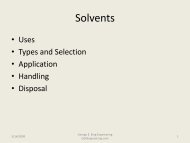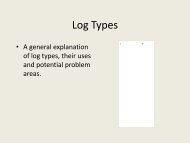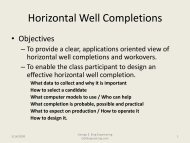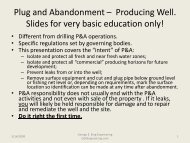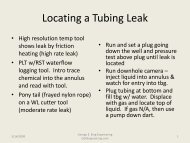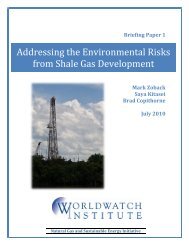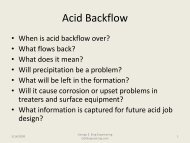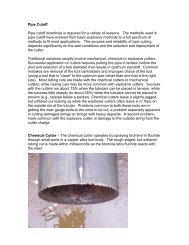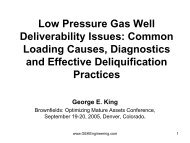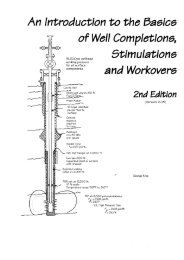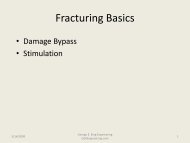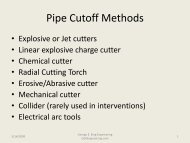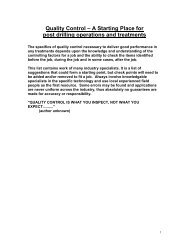Well Heads, Chokes and SSSVs - George E King Engineering
Well Heads, Chokes and SSSVs - George E King Engineering
Well Heads, Chokes and SSSVs - George E King Engineering
You also want an ePaper? Increase the reach of your titles
YUMPU automatically turns print PDFs into web optimized ePapers that Google loves.
Chapter 5: <strong>Well</strong> <strong>Heads</strong>, <strong>Chokes</strong> <strong>and</strong> <strong>SSSVs</strong><br />
<strong>Well</strong>heads<br />
<strong>Well</strong>heads are the connection point for the tubulars <strong>and</strong> the surface flow lines as well as being the surface<br />
pressure control point in almost any well operation. They are rated for working pressures of 2000 psi to<br />
15,000 psi (or greater). They must be selected to meet the pressure, temperature, corrosion, <strong>and</strong><br />
production compatibility requirements of the well. There are three sections of a wellhead, <strong>and</strong> each serves<br />
a function in the completion of a well. 1 The outermost cemented casing string, usually either the conductor<br />
pipe or the surface string, is fitted with a slip type or threaded casing head. The head, Figure 5.1, also<br />
called a well head flange, supports the BOPs during drilling <strong>and</strong> the rest of the well head during production.<br />
A port on the side of the head allows communication with the annulus when another casing string is run.<br />
For all additional casing strings, a casing spool is used. The spool has a flange at each end. The flange<br />
diameter, bolt pattern <strong>and</strong> seal assembly are a function of the spool size range <strong>and</strong> the pressure rating.<br />
When specifying well head equipment, all pieces should be rated for the same pressure. The tubing is hung<br />
<strong>and</strong> isolated in a tubing spool. The tubing is "spaced out" to come to the right height for the seal assembly<br />
by the use of pup joints (short pieces of tubing). Annulus communication is provided in the ports on the side<br />
of the spools.<br />
Each spool has alignment screws for aligning the tabular in the center of the spool. Alignment is critical<br />
since each flange connection (bolt hole alignment) depends on the last casing being in the center of the<br />
spool below it.<br />
Multiple tubing strings can be accommodated by special heads. These head designs depend on isolation<br />
seals in the well head <strong>and</strong> multiple tubing spools. Setting the tubing <strong>and</strong> casing strings in tension is a<br />
common practice to offset the effects of buckling created by tubing expansion when hot fluids are<br />
produced.
The seal between each section is a single metal ring that fits in grooves in the top <strong>and</strong> base of connecting<br />
spool sections. The pressure to seat these metal-to-metal seals is provided by compression when the<br />
section flanges are bolted together. Oil is applied to the seals before bolting down the flanges. Various<br />
methods <strong>and</strong> devices for sealing have been tested for seals. Elastomers are subject<br />
to attack by solvents 2 <strong>and</strong> temperature cycling. 3 Metal to metal seals are the most common, especially in<br />
severe service areas. In sour gas (hydrogen sulfide) areas, special metals are often needed for<br />
wellheads. 4<br />
The final section of the wellhead is the familiar "Christmas tree" arrangement of control valves. The tree sits<br />
on top of the tubing hanger spool <strong>and</strong> holds the valves used in well operation, Figure 5.2. The master valve<br />
is a full opening valve that is the main surface control point for access to the tubulars. It is always fully open<br />
when the well is producing or when a workover is in progress. The working pressure rating of the master<br />
valve must be sufficient to h<strong>and</strong>le full wellhead pressure. If a valve or fitting in the upper part of the tree<br />
must be replaced, the master valve can be closed without killing the well (for all wells with a clear tubing,<br />
i.e., no rods). On very high pressure (Ps > 5000 psi) or hazardous wells, there may be two master valves; a<br />
backup for insurance against leaks in the main valve. The wing valve (often two valves) are mounted<br />
immediately above the master valve in a separate spool. Produced fluids leave the wellhead at the wing<br />
valve connection. The purpose of multiple wing valves is to allow changing of chokes or flow line repair<br />
without interrupting well flow. The swabbing or lubricator valve is mounted above the wing valve <strong>and</strong> is<br />
used to open the well to entry by a toot string. A schematic of the wellhead <strong>and</strong> tubulars is shown in Figure<br />
5.3.<br />
The choke is the only device used to limit the production of flowing fluids. Using a valve, such as the wing<br />
valve or master valve, to limit fluid flow would allow fluid flow (possibly with solids) to cross the sealing<br />
surface of the valve. This could lead to erosion <strong>and</strong> a leaking master valve <strong>and</strong> would require killing the well<br />
to replace the valve.
A connection on top of the swabbing valve can be used to mount a lubricator. A lubricator is a pressure<br />
rated tube that allows a tool string to be lowered into the well, even while the well is flowing. One end of the<br />
lubricator is attached to the swabbing valve <strong>and</strong> the other contains a seal assembly that seals against the<br />
wireline that is used to run the tool. Since the lubricator st<strong>and</strong>s straight up to allow the tool string to drop<br />
into the well, the length of the lubricator (<strong>and</strong> the length of the tool string) is controlled by the length of<br />
lubricator tube that can be safely supported by the equipment on location. A more detailed discussion of<br />
the lubricator will be given in the chapter covering wireline techniques.<br />
Subsea <strong>Well</strong>heads<br />
A special type of well head is involved in a subsea well. In subsea wells, the wellhead sits on the ocean's<br />
bottom at depths from less than a hundred feet to over 2500 ft. Access is much more difficult than in a<br />
surface well, thus subsea completions require a well to be low maintenance, usually a sweet gas or flowing<br />
oil well. The wellheads for these wells must be self contained units with controls that can be manipulated by<br />
remote action at the well head by a ROT (remotely operated tool), by diver or by ROV (remotely operated<br />
vehicle). Almost all subsea operations, including drilling, begin after a template is installed on the ocean<br />
floor. The template serves as a locator for almost all tools used to drill, complete <strong>and</strong> workover the well. A<br />
schematic of the template <strong>and</strong> several workover <strong>and</strong> completion "tools" are shown in Figure 5.4. The<br />
modular work devices in the figure are characteristic of a surface wireline assisted operations. The
production well head that fits into the template must provide the same solid connection to the well as all<br />
l<strong>and</strong> based well. Because of the remote or diver operation, however, appearances are vastly different than<br />
a surface well. Replaceable components of the wellhead such as valves <strong>and</strong> chokes are often equipped<br />
with guide bars to assist in remote replacement.
Coiled Tubing <strong>Well</strong> <strong>Heads</strong><br />
The use of coiled tubing for recompletion <strong>and</strong> even initial completion of some wells requires the use of<br />
special hangers or even complete wellheads that are designed especially for coiled tubing. Coiled tubing is<br />
being used in place of conventional tubing in some wells to minimize rig cost or to avoid killing the well to<br />
run tubing. Because of the lack of connections, coiled tubing can be run through stripping rubber seals in<br />
the BOP or through a st<strong>and</strong>ard stripper head. Hanging the tubing off in the wellhead requires slips; <strong>and</strong>, in<br />
live well workovers, these can be attached to the tubing <strong>and</strong> snubbed through the BOP stack to the slip<br />
bowl portion of the wellhead, or the slips can be made a part of the wellhead <strong>and</strong> activated from outside.<br />
Coiled tubing completions may incorporate well ore bolt-on components or may be completely spool-able<br />
including gas lift valves, <strong>SSSVs</strong> <strong>and</strong> packers.<br />
Examples of a hanger element are shown in Figure 5.5 <strong>and</strong> 5.6. These heads require a setting point below<br />
the master valve for a workover where the wellhead is nippled down. For low cost recomple-tions where the<br />
existing tubing <strong>and</strong> wellhead will not be removed, the coiled tubing is set through the existing master valve<br />
with the coiled tubing hanger <strong>and</strong> a new master valve set above the old master valve. Success of the coiled<br />
tubing completions <strong>and</strong> recompletions has been good when the tubing is sized correctly for the well<br />
condition.<br />
Hydrate Control in Coiled Tubing Completions<br />
Coiled tubing offers very good opportunities for recompletion or even initial completion of some wells,<br />
however, coiled tubing is particularly susceptible to collapse <strong>and</strong> compaction from production forces if an<br />
ice plug or hydrate plug forms either in the tubing or around the tubing. Problems in some operations where<br />
ice plugs have formed in the annulus during flow have caused sufficient force to collapse <strong>and</strong> compact<br />
coiled tubing to the point where 30-40 ft of coiled tubing are compressed into an area only 5 or 6 ft long.<br />
The only way to prevent ice plugs is either to control the rate of the gas flow so that the temperature drop<br />
during gas expansion does not create ice plugs or to inject a freeze inhibitor below the hydrate point to<br />
totally inhibit the formation of the ice.
Example: <strong>Well</strong>head configuration - For a gas producing formation at 9600 ft with a reservoir pressure<br />
gradient of 0.55 psi/ft, what is the minimum wellhead equipment pressure rating (in psi) needed to cover<br />
production or fracture stimulation with an 8.5 Ib/gal frac fluid, when fracturing the zone at 9600-11000. The<br />
friction pressure down the 4-1/2 in., 12.6 Ib/ft, N-80 work string (packer set at 9300 ft) during the frac will be<br />
75 psi/1000 ft of tubing length. During production flow the friction pressure is 10 psi/1000 ft. Shut in during<br />
production will be with a full column of gas (0.1 psi/ft). St<strong>and</strong>ard safety factor for well head working<br />
pressure is 80% of rated capacity.<br />
Solution: Calculate highest possible surface pressure.<br />
1. Max producing pressure (shut in with gas column) = (9600 x (0.55-0.1) = 4320 psi<br />
Don't use the friction pressure on producing since the worst production surface pressure case is static with<br />
gas in the tubing.<br />
2. Max fracture stimulation surface pressure = (0.83 x 9600) - (9600 x (8.5 x 0.052)) + (9.3 x 75) (7968<br />
psi) D (4243 psi) + (698 psi) = 4423 psi<br />
Minimum wellhead pressure rating 4423/0.8 = 5529 psi<br />
<strong>Chokes</strong><br />
<strong>Chokes</strong> hold a backpressure on a flowing well to make better use of the gas for natural gas lift <strong>and</strong> to<br />
control the bottomhole pressure for recovery reasons. In vertical pipe flow, the gas exp<strong>and</strong>s rapidly with<br />
decreasing hydrostatic head <strong>and</strong> the liquid moves in slugs through the tubing. The potential gas lift energy<br />
is rapidly lost <strong>and</strong> liquids fall back <strong>and</strong> begin to accumulate over the perforations. Accumulating liquids hold<br />
a back pressure on the formation. If enough liquids accumulate, the well may "die" <strong>and</strong> quit flowing. A<br />
choke holds back pressure by restricting the flow opening at the well head. Back pressure restricts the<br />
uncontrolled expansion <strong>and</strong> rise of the gas <strong>and</strong> thus helps keep the gas dispersed in the liquids on the way<br />
up the tubing. <strong>Chokes</strong> may be variable or have a set opening, Figure 5.7. The set openings, often called<br />
"beans," are short flow tubes. They are graduated in 64ths of an inch. Common flow sizes are about 8<br />
through more than 20 (in 64ths) for small to moderate rate gas wells. Liquid producers <strong>and</strong> high rate gas<br />
wells us 20+ choke settings. The size of the choke needed depends on reservoir pressure, tubing size,
amount of gas, <strong>and</strong> amount <strong>and</strong> density of liquids. Variable chokes may use a increasing width slot design<br />
that allows quick resetting. They are useful on well cleanups following stimulation where choke size can<br />
vary over the course of a single day from 4/64ths to over 40. They are also used where periodic liquid<br />
unloading necessitates frequent choke size changes.<br />
Solids in the produced fluids are the major source of failures for chokes. Abrasion from s<strong>and</strong>, scale, ice,<br />
corrosion particles <strong>and</strong> other solids can cut out the choke restriction <strong>and</strong> cause the well to load up<br />
with fluids <strong>and</strong> die. Choke abrasion from solids <strong>and</strong> cavitation is increased when large pressure drops are<br />
taken. In these situations, choke life is often measured in minutes. For better performance at high pressure<br />
drops, take the drop in stages across three or more choke sets in series. The problem is with gas<br />
expansion; as gas goes from 5000 psi to atmospheric pressure, the gas exp<strong>and</strong>s 340 fold, with a similar<br />
increase in velocity. The same pressure drop, taken in series from 5000 to 3000, from 3000 to 500 <strong>and</strong> 800<br />
to atmospheric results in gas volume (<strong>and</strong> velocity) increases of 136 fold (5000 psi to 3000 psi), 150 fold<br />
(3000 psi to 800 psi) <strong>and</strong> 54 fold (500 psi to atmospheric). The 340 fold total drop is the same, but the<br />
velocity increase across any one choke is significantly reduced.<br />
Subsurface Safety Valves<br />
When a well head is damaged, through accident or even terrorist incident, the fluids from a producing well<br />
can continue to flow, creating pollution <strong>and</strong> safety problems. One solution to the wild well potential is the<br />
use of safety valves. Safety valves are used to automatically halt the flow of fluid from a well in the event<br />
that the surface equipment of the well is damaged. Safety valves located at the surface are surface safety<br />
valves (SSVs) <strong>and</strong> those located below the wellhead are subsurface safety valves (<strong>SSSVs</strong>). SSVs are<br />
located above the master valve <strong>and</strong> below the choke <strong>and</strong>/or beyond the choke on the production line.<br />
<strong>SSSVs</strong> are located in the tubing string below the ground or mud line. Together, the surface safety valves<br />
<strong>and</strong> subsurface safety valves form a redundant system of fail-safe valves. The valves are designed to be<br />
fail-safe; they are designed in a normally closed position. Opening of the valves requires application of a<br />
pressure to the valve to hold the valve open. When the pressure is lost, all safety valves close<br />
automatically. Safety valves are typically used offshore, in environmentally sensitive areas <strong>and</strong> in some<br />
remote locations on unattended wells.<br />
Any requirement for a subsurface safety valve <strong>and</strong> the depth of the valve below the wellhead depends<br />
upon the application <strong>and</strong> local government requirements. In offshore U.S., <strong>SSSVs</strong> are required <strong>and</strong> the<br />
subsurface safety valve is usually set in the tubing string 100 ft or more below the mud line. In the event of<br />
an accident or disaster, in which the wellhead equipment is partially or completely damaged or removed,<br />
the valves will shut in the wells <strong>and</strong> prevent pollution <strong>and</strong> fire.<br />
The pressure that keeps the safety valves open is supplied by a small pump in a hydraulic-controlled<br />
panel on the surface platform. 12 The pump is an automatic hydraulic supply unit, powered usually by clean<br />
gas pressure. The pump supplies the control line with a 7 Ib/gal clean hydraulic oil at a set pressure. Other<br />
types of actuation systems that have been tried for control of the <strong>SSSVs</strong> include differential flowing<br />
pressure, 10 electric downhole solenoid, 11 velocity actuated, 9 gas, 13 electromagnetic wave control (directed<br />
through the sediments) 14-15 <strong>and</strong> through loss of tension in the tubing string.
The earliest valves were designed to close if the well flow reached some maximum rate <strong>and</strong> were used<br />
almost exclusively offshore. The idea behind the design was that the valve would close if the platform was<br />
damaged in a storm. The problem with this type of downhole "flow sensitive" control, was that the valves<br />
were continually in need of resizing as the well's production capacity declined (reservoir depleted). The<br />
maximum rate trigger-mechanism was also a nuisance when high rate flow of gas was needed to meet<br />
market dem<strong>and</strong> or when liquid slugged through the tubing. SSSV control is now almost exclusively from the<br />
surface via a small hydraulic control line on the outside of the tubing. If the pressure supply is interrupted,<br />
the valves closes automatically.<br />
The valve sealing mechanism varies with manufacturer <strong>and</strong> the age <strong>and</strong> type of the valve. Most <strong>SSSVs</strong> use<br />
either a flapper valve or a ball valve with the current favorite being the flapper. The seat <strong>and</strong> flapper unit are<br />
protected from the well stream by a spring opposed sleeve that slides through the open flapper <strong>and</strong> isolates<br />
both the seat <strong>and</strong> the flapper. The sleeve is held in place by the hydraulic control pressure. The flapper<br />
assembly may be elastomer seal, metal-to-metal or a mixture of the two systems. Metal-to-metal seal units<br />
can be built for pressures in excess of 25000 psi. Ball valve units are equipped with spring loaded<br />
mechanisms that rotate the throat out of the well stream when the hydraulic opening pressure is removed.<br />
Examples of flapper <strong>and</strong> ball valves are shown in Figure 5.8. Other types of seal mechanisms have also<br />
been tried.<br />
The two conveyance types of subsurface safety valves are tubing retrievable <strong>and</strong> wireline retrievable.<br />
Tubing retrievable valves are run as part of the tubing string (the valve body is made up as part of the<br />
string) whereas wireline retrievable valves can be run <strong>and</strong> retrieved from a profile set in the tubing string. In<br />
the U.S., the tubing retrievable valves are almost twice as popular as the wireline retrievable valves, while<br />
in non-U.S. areas, the wireline valves are more popular than the tubing retrievables. The reasons for the<br />
popularity differences are found in personal preferences, workover cost differences <strong>and</strong>, to some extent, in<br />
regulations regarding well operation. The benefits of the tubing retrievable valve is that it has a fully<br />
opening bore, with very little obstruction to the flowing fluids. One disadvantage is that if there is a problem<br />
with the valve, the tubing must be pulled to the depth of the valve for service. This requires use of a rig; a<br />
large cost for many remote platforms. The tubing retrievable valves also require a relatively large upper<br />
casing section because of large valve body. The large outer body diameter (over 7 in. for a 4-1/2 in. bore<br />
valve) is necessitated by the flapper, spring <strong>and</strong> pressure equalization equipment within the valve. The<br />
wireline retrievable subsurface safety valve can be replaced by wireline without pulling the well, but it<br />
restricts the opening through which fluids may flow. The flow restriction for this type of valve may reduce 4-<br />
1/2 in. tubing to about a 1-1/2 in. bore over the 5 to 6 ft length of the valve. For most wells, this is not a<br />
severe restriction over a very short length. In wells that produce paraffin or scale, however, this flow<br />
restriction, especially near the top of the tubing may serve as the site for solids deposition <strong>and</strong> promote<br />
rapid valve failure. In wells that produce s<strong>and</strong>, any restriction may be a site for abrasion. In wells that do not<br />
precipitate or produce solids, the valves are often a good choice, especially in areas where well<br />
deliverability rate is critical <strong>and</strong> time consuming workovers (such as pulling the string to replace a tubing<br />
retrievable SSSV) must be avoided. Wireline retrievable valves must be set in a special profile that is made<br />
up as part of the string. The profile seat is connected to the same type of external control line that is used
for the tubing retrievable valve. A set of seals on the outside of the wireline valve isolates the hydraulic<br />
pressure port in the profile <strong>and</strong> allows a connection to the valve control mechanism. If the valve fails or<br />
malfunctions, the wireline unit can be removed <strong>and</strong> replaced by a low cost wireline operation with minimum<br />
productivity interruption.<br />
Safety valve failures are rare but have been documented. When a valve fails to close, it is classified as a<br />
failure. When a valve fails to open, it is classified as a malfunction. The difference between the two labels<br />
comes from the design intent of the valve. Since the valve is designed to close when surface control<br />
pressure is lost, a failure is failure to close. Either event is troublesome.<br />
One study on the reliability of <strong>SSSVs</strong>, showed the valves to have a failure rate that was on the order of 0.8<br />
to 2.3% in normal operations. 16 One of the biggest reasons for SSSV failure (of valves tested) is plugging of<br />
the sealing mechanism with paraffin, scale, produced s<strong>and</strong>, ice <strong>and</strong> other solids. 8,23-25 It is very important to<br />
operate the valves periodically so debris can be removed from the assembly <strong>and</strong> that valve's internal<br />
mechanism can be lubricated. This operation is known as "exercising" the valve <strong>and</strong> is recommended to be<br />
done once per month. To exercise the valve, the wing vent is usually closed to shut the well in <strong>and</strong> the<br />
safety valve is open <strong>and</strong> closed several times. Merely releasing <strong>and</strong> restoring the hydraulic pressure at the<br />
surface will not confirm that the valve has actually closed. After the hydraulic control pressure is released, a<br />
few hundred psi can be bled off the tubing at the surface. If the pressure does not come back to initial shutin<br />
pressure, then the valve is sealing. The amount of pressure that needs to be bled off at the surface<br />
depends of what seat material is in the valve. Elas-tomer seals are tested at about 500 psi while metal-tometal<br />
seals are usually tested at least 500 to over 1000 psi. The recommended test pressure is available<br />
from the valve manufacturer. A regular maintenance schedule may be a legal requirement of operation. 16-19<br />
Reliability of the valves is very good if precautions are taken on regularly "exercising" the control<br />
mechanism. All of the 36 wells on the ill-fated Piper Alpha platform in the North Sea were equipped with<br />
<strong>SSSVs</strong> as per regulations. After the platform was destroyed, the fire was caused by the uncontrolled<br />
volume of produced gas in the pipeline (nearest shutoff was reportedly 1-1/2 miles away). The fire-fighting<br />
crew reported only minor leaks from tubing of the shutin wells. In Kuwait, ten wells of the 700+ that had well<br />
heads damaged or destroyed were reportedly equipped with <strong>SSSVs</strong>. The valves prevented fires on those<br />
wells.<br />
Opening the valve, either on initial well startup or after shut-in to check valve operation should follow a set<br />
of simple rules. To prevent valve damage, the pressure on both sides of the valve must be equalized. If the<br />
valve is a flapper design, the pressure is best equalized by pumping down the tubing to open the valve. If<br />
the unit is a ball valve, it may have to be opened by activation of the hydraulic pressure control unit.<br />
Flapper valves can also be opened by hydraulic actuator pressure. With either system, if the valve must be<br />
opened by the hydraulic mechanism, the differential pressure across the valve must be equalized before<br />
valve opening to prevent valve damage. Pressure equalization is accomplished with internal baffles that<br />
allow controlled flow of gas or liquid through the a part of the valve body. After pressure above <strong>and</strong> below<br />
the valve is equalized, the valve can easily be opened. If the valve is opened with a differential pressure<br />
across the valve, the fluid flow across the seal may cause erosion of the valve face.<br />
An additional element of consideration for <strong>SSSVs</strong> is the construction material. Since they are directly in the<br />
flow stream, the <strong>SSSVs</strong> must be designed to withst<strong>and</strong> operational corrosion or erosion forces.<br />
Construction materials of corrosion resistant metals such as Incalloy or Hastelloy are common.<br />
Selection of the type of SSSV depends on well conditions. 7 Included in the considerations are legal<br />
requirements, depth of placement, pollution st<strong>and</strong>ards, dual strings, 20,21 subsea wellhead, 22 ? casing size<br />
near surface, presence of kill strings, annular flow, cost of workovers, frequency of workovers, type of<br />
workovers, deliverability obligations <strong>and</strong> the cost of the valve. When these <strong>and</strong> other variables such as<br />
pressure, setting depth, <strong>and</strong> temperature are considered, a decision can generally be made by examining<br />
the requirements <strong>and</strong> behavior of the available equipment. 8<br />
Setting depth of a valve depends on the ability of that valve to close in the event of an accident. The SSSV<br />
is rated with a closing pressure, Fc If the control line pressure drops below Fc the valve closes, shutting in<br />
the well. The Fc value effectively limits how deep the valve can be set since either control line hydrostatic<br />
fluid pressure or annular fluid hydrostatic (in the event of a control line break) could keep the valve open if<br />
the fluid hydrostatic exceeded the SSSV closing pressure. A simple formula translates the closing pressure<br />
rating into maximum set depth.<br />
Set Depth = maximum set depth of SSSV
Fc = closing pressure rating of SSSV<br />
Fs = a safety factor, Fs = 0.15 Fg, usual minimum is 75 psi.<br />
MHFG= maximum hydraulic fluid gradient.<br />
In the case of the valve with Fc = 350 psi, an empty (unpressured annulus) <strong>and</strong> a 7 Ib/gal hydraulic oil, the<br />
set depth is:<br />
The 0.364 psi/ft is the gradient of 7 Ib/gal fluid <strong>and</strong> 75 psi was used because Fg = 0.15 x 350 = 53 psi.<br />
If the annulus is liquid filled (or gas under pressure), the MHFG that would be used is the maximum<br />
gradient produced at the SSSV. For example, a 15 Ib/gal packer fluid in the annulus would change the<br />
maximum setting depth for the same spring to:<br />
Example: An offshore platform uses a SCSSV, set at 450 ft below the mud line (ocean floor). The water<br />
depth is 300 ft <strong>and</strong> the platform is 75 ft above the sea surface. The hydraulic fluid used for valve operation<br />
has a density of 8.4 Ib/gal. Sea water density is 8.5 Ib/gal. The annulus of the well is filled with inhibited sea<br />
water (8.5 Ib/gal). What is the minimum flapper closure pressure (Fc) needed (in psi) for operation under all<br />
environments including loss of the control line at the downhole valve. FS = 75 psi<br />
Solution: Set Depth = [Fc D Fs] / MHFG, Fc = [Set Depth x MHFG] + Fs There<br />
are two possible hydraulic fluid <strong>and</strong> set depth combinations:<br />
1. at operating conditions, set depth = 450 + 300 + 75 = 825 ft, The hydraulic density » (8.4 x 0.052) =<br />
0.437 psi/ft for this condition.<br />
2. at "disaster" conditions (loss of control line at valve) set depth = 450 + 300 = 750 ft, (note that the air<br />
gas is not use D <strong>and</strong> fluid now is sea water). The hydraulic fluid density = 8.5 x 0.052 = 0.442 for this<br />
condition.<br />
Condition 1, Fc = (825 x 0.437) + 75 = 436 psi Condition<br />
2, Fc = (750 x 0.442) + 75 = 407 psi<br />
The minimum flapper closure pressure needed is 436 psi<br />
The other safety valve path that must be considered is the annular area. Annular safety control is necessary<br />
in areas that require SSSV isolation where the annular area is or could become a flow path. The<br />
annular pressure control systems that are currently on the market are packer type devices that use an<br />
applied hydraulic force to hold the annular flow channels open. All of these devices serve as a hanger so<br />
that the tubing suspension is maintained regardless of wellhead damage. Hanging significant tubing weight<br />
from these devices causes significant problems because of potential casing deformation. Two approaches<br />
have helped cure this problem. The packer slip assembly has been enlarged in one model to spread out<br />
the load. in the other approach, a casing profile is run in the casing string <strong>and</strong> the tubing hanger is set in<br />
the profile.<br />
A special case in subsurface safety valves is the coiled tubing completion, Figure 5.9. This completion, all<br />
completely spoolable onto a coiled tubing reel can be more easily pulled in the event of a workover.
References<br />
1. Buzarde, L. E., Jr. Kastor, R. L, Bell, W. T., DePriester, C. L: "Production Operations Course I <strong>Well</strong><br />
Completions," SPE, 1972.<br />
2. Bazile, D. J., II, Kluck, L. M.: "New <strong>Well</strong>head Equipment for Old Oilfields," SPE 16122, SPE/IADC<br />
Conference, New Orleans, March 15-18,1987.<br />
3. Coxe, B., Pyle, C. L.: "<strong>Well</strong>head Innovations for Hot, High-Pressure <strong>Well</strong>s," J. Pet. Tech. (February<br />
1983), pp. 284-290.<br />
4. Fowler, E. D., Rhodes, A. F.: "Checklist Can Help Specify Proper <strong>Well</strong>head Material," Oil <strong>and</strong> Gas J.<br />
(January 24, 1977), pp. 62-65.<br />
5. Bleakley, W. B.: "The How <strong>and</strong> Why of Downhole Safety Valves," Petroleum Engineer (January 1986),<br />
pp. 48-50.<br />
6. Peden, J. M.: "Rationality in Completion Design <strong>and</strong> Equipment Selection in the North Sea," Paper SPE<br />
15887 presented at SPE European Petroleum Conference, London, October 20-22, 1986, pp.347-361.<br />
7. Krause, W. F. <strong>and</strong> P. S. Sizer: "Selection Criteria for Subsurface Safety Equipment for Offshore<br />
Completions," Journal of Petroleum Technology (July 1970), pp. 793-799.<br />
8. Nystrom, K. 0. <strong>and</strong> D. W. Morris: "Selecting A Surface-Controlled Subsurface Safety Valve for Deep,<br />
Hot, High-Pressure, Sour Gas Offshore Completions," Paper SPE 11997 presented at 58th Annual<br />
Technical Conference <strong>and</strong> Exhibition, San Francisco, October 5-8, 1983, pp. 1-4.<br />
9. Beggs, H. D.; J. P. Brill; E. A. Proano, Roman-Lazo, C. E.: "Selection <strong>and</strong> Sizing of Velocity-Actuated<br />
Subsurface Safety Valves," Trans. ASME, June 1980, Vol. 102, pp. 82-91.<br />
10. Gano, J. C.: "Differential Sensing Direct-Control Gas Storage <strong>Well</strong> Safety Valve," Paper SPE 19086<br />
presented at the SPE Gas Technology Symposium, Dallas, June 7-9, 1989, pp. 287-294.<br />
11. Gresham, J. S. <strong>and</strong> T. A. Turcich: "Development of a Deepset Electric Solenoid Subsurface Safety<br />
Valve System," Paper SPE 14004 presented at the Offshore Europe 85 Conference, Aberdeen,<br />
September 10-13, pp. 1-9.<br />
12. Schaefer, H.: "Subsurface Safety Valves," Paper OTC 1295 presented at Second Annual Offshore<br />
Technology Conference, Houston, April 22-24,1970, pp. 681-688.<br />
13. Morsi, K. M.: "Surface <strong>and</strong> Downhole Production Safety Systems for Sour Oil <strong>and</strong> Gas <strong>Well</strong>s," Paper<br />
SPE 13743 presented at Middle East Oil Technical Conference <strong>and</strong> Exhibition, Bahrain, March 11-14,<br />
1985, pp. 1-6.<br />
14. Drakeley, B. K.: "Electromagnetic waves used for valve control," Offshore (September 1987), pp.53-54.<br />
15. Kleckner, J. J.; R. C. Dickerson; P. M. Snider; J. A. Zublin; R. L. Sphan; P. F. Menne; J. H. Van Der
Lichte; B. H. Ter Horst; N. H. Akkerman; L. H. Rorden; H. S. More; J. E. Kattner; A. Samuels;<br />
R. A. Wendt; T. Hoh; E. Beauregard; P. L Ferguson; P. J. H. Carnell <strong>and</strong> H. H. Ctark: "Production<br />
Operations Forum," Paper SPE 15468 presented at the 61st Annual Technical Conference <strong>and</strong><br />
Exhibition of the Society of Petroleum Engineers, New Orleans, October 5-8, 1986, pp. 1-6.<br />
16. Medley, E. L.: "Experience With Surface Controlled Sub-Surface Safety Valves," Paper EUR 32<br />
presented at European Offshore Petroleum Conference <strong>and</strong> Exhibition, London, October 24-27, 1978,<br />
pp. 257-262.<br />
17. Molnes, E.; M. Raus<strong>and</strong> <strong>and</strong> B. Lindqvist: "SCSSV Reliability Tested In North Sea," Petroleum Engineer<br />
(November 1987), pp. 38-40.<br />
18. Engen, G. <strong>and</strong> M. Raus<strong>and</strong>: "Reliability Studies Test SCSSVs In The North Sea," Petroleum Engineer<br />
(February 1984), pp. 30-36.<br />
19. Busch, J. M.; B. J. Policky <strong>and</strong> D. C. G. Llewelyn: "Subsurface Safety Valves: Safety Asset or Safety<br />
Liability?" Journal of Petroleum Technology (October 1985), pp. 1813-1818.<br />
20. Geyelin, J. L.: "Down Hole Safety Valve for Concentric Completion," Paper SPE 16536 presented at<br />
Offshore Europe 87, Aberdeen, September 8-11, pp. 1-9.<br />
21. Calhoun, M. B.; M. Deaton <strong>and</strong> J. W. Tamplen: "Subsurface Safety Systems for TLP Completions,"<br />
Paper SPE 12996 presented at the European Petroleum Conference, London, October 25-28, 1984, pp.<br />
313-315.<br />
22. ;Yonker, J. H.: "Newest Through-Flowline Retrievable Safety Valves for Subsea Completions," J. Pet.<br />
Tech., (Nov. 1984), p. 1922-1928.<br />
23. Going, W. S. <strong>and</strong> R. E. Pringle: "Safety Valve Technology for the 1990's," Paper SPE 18393 presented<br />
at SPE European Petroleum Conference, London, October 16-19, 1988, pp. 545-552.<br />
24. Morris, A. J.: "Elastomers Are Being Eliminated in Subsurface Completion Equipment," Paper SPE<br />
13244 presented at the 59th Annual Technical Conference <strong>and</strong> Exhibition, Houston, September 16-19,<br />
1984,pp.1-4.<br />
25. Mason, P. G. T.: "Downhole High-Pressure Equalizing Safety Valves: A Solution-Variable Labyrinth<br />
Seals," Paper OTC 5576 presented at the 19th Annual OTC, Houston, April 27-30, 1987, pp. 217-227.<br />
26. Raulins, G. M.: "Safety by Down-Hole <strong>Well</strong> Control," J. Pet. Tech. (March 1972), p. 263-271.<br />
27. Rubli, J.: "New Developments In Subsurface Safety Valve Technology."<br />
28. Sides, W. M., Going, W.: "Controlling Self Equalizing Velocity Extends Valve Life," Petroleum Engineer<br />
Int., February 1992.<br />
29. Hopper, Christopher T; "Simultaneous Wireline Operations from a Floating Rig with a Subsea<br />
Lubricator", SPE Production <strong>Engineering</strong> (August 1990), pp. 270-274.<br />
30. O'Brien, E. J. Ill, Hetl<strong>and</strong>, Torger; "The Underwater Production System", SPE (February 1991), pp. 33-<br />
39.<br />
31. <strong>King</strong>, Gregory W.; "Drilling <strong>Engineering</strong> for Subsea Development <strong>Well</strong>s", SPE (September 1990), pp.<br />
1176-1183.<br />
32. Cyvas, M. K.; "Subsea Adjustable Choke Valves: A Focus on a Critical Component", SPE (August<br />
1989), pp. 301-308.<br />
33. Simpson, D. M., Pearce, J. L.; "Downhole Maintenance of Subsea Completions", SPE (May 1989), pp.<br />
161-166<br />
34. Dines, Chris, Cowan, P., Headworth; "An Operational Subsea Wireline System," Journal of Petroleum<br />
Technology (February A 1989), pp. 171-176.<br />
35. Dawson, A. P., Murray, M. V.; "Magnus Subsea <strong>Well</strong>s: Design, Installation, <strong>and</strong> Early Operational<br />
Experience", SPE (November'^ 1987), pp. 305-312.<br />
36. Reynolds, P. W., Marquette, L. J.; "Completing Subsea <strong>Well</strong>s at Ekofisk", Petroleum Engineers<br />
International, (1978), pp. 57-60.<br />
37. "Shell tries Recessed Subsea Completion", Drilling Contractor (April 1982), pp. 132-136.<br />
38. Kelly, A. 0., Bourgoyne, Dr., Jr., A. T., Holden, Dr. W. Ft.; "A Computer Assisted <strong>Well</strong> Control Safety<br />
System for Deep Ocean <strong>Well</strong> Control", Paper presented at International <strong>Well</strong> Control<br />
Symposium/Workshop in Baton Rouge, Louisiana, (November 27-29, 1989), pp. 1-18.
39. Davis, R. J. R., Pond, R. J.; "Development of the Subsea Completion System for the Highl<strong>and</strong>er Field",<br />
Journal of Petroleum Technology, (April 1986), pp. 453-460.<br />
40. Morrill, David L; "The Simple Subsea <strong>Well</strong> Concept", SPE (September 1979), pp. 1083-1091.



